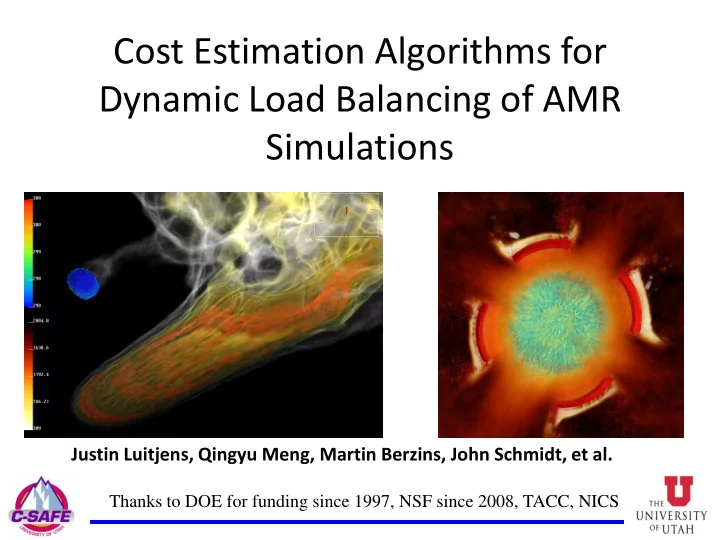

Cost Estimation Algorithms for Dynamic Load Balancing of AMR Simulations Justin Luitjens, Qingyu Meng, Martin Berzins, John Schmidt, et al. Thanks to DOE for funding since 1997, NSF since 2008, TACC, NICS
Uintah Parallel Computing Framework • Uintah - far-sighted design by Steve Parker : – Automated parallelism • Engineer only writes “serial” code for a hexahedral patch • Complete separation of user code and parallelism • Asynchronous communication, message coalescing – Multiple Simulation Components • ICE, MPM, Arches, MPMICE, et al. – Supports AMR with a ICE and MPMICE – Automated load balancing & regridding – Simulation of a broad class of fluid-structure interaction problems
Uintah Applications Plume Fires Angiogenesis Industrial Flares Micropin Flow Explosions Sandstone Compaction Virtual Foam Soldier Shaped Charges Compaction
How Does Uintah Work? Patch-Based Domain Task-Graph Specification Decomposition • Computes & Requries
How Does Uintah Work? Simulation Models Regridder (Arches, ICE, MPM, (EoS , Constitutive, …) MPMICE, MPMArches , …) Callbacks Tasks Simulation Data Tasks Controller Archiver Scheduler Callbacks XML Load Checkpoints Problem MPI Balancer Specification Data I/O Domain Tuning Expert Expert
Legacy Issues • Uintah is 12+ years old • How do we scale to today’s largest machines? – Identify and understand bottlenecks • TAU, hand profiling, complexity analysis • Reduce O(P) Dependencies – Look at memory footprint? – Redesigned components for O(100K) processors • Regridding, Load Balancing, Scheduling, etc
Uintah Load Balancing • Assign Patches to Processors – Minimize Load Imbalance – Minimize Communication – Run Quickly in Parallel • Uintah Default: Space-Filling Curves • Support for Zoltan In order to assign work evenly we must know how much work a patch requires
Cost Estimation: Performance Models G r : Number of P r : Number of E r,t : Estimated Time Grid Cells Particles E r,t = c 1 G r + c 2 P r + c 3 c 1 , c 2 , c 3 : Model Constants • Need to be proportionally accurate • Vary with simulation component, sub models, compiler, material, physical state, etc . Can estimate constants using least squares at runtime G 0 P 0 1 c 1 O 0,t O r,t : Observed Time = … … … c 2 … What if the constants G n P n 1 c 3 O n,t are not constant?
Cost Estimation: Fading Memory Filter O r,t : Observed Time E r,t : Estimated Time α : Decay Rate E r,t+1 = α O r,t + (1 - α ) E r,t = α (O r,t - E r,t ) + E r,t Error in last prediction • No model necessary Compute per patch • Can track changing phenomena • May react to system noise • Also known as: • Simple Exponential Smoothing • Exponential Weighted Average
Cost Estimation: Kalman Filter, 0 th Order O r,t : Observed Time E r,t : Estimated Time E r,t+1 = K r,t (O r,t - E r,t ) + E r,t Update Equation: K r,t = M r,t / (M r,t + σ 2 ) Gain: a priori cov: M r,t = P r,t-1 + φ a posteri cov: P r,t = ( 1 - K r,t ) M r,t P 0 = ∞ • Accounts for uncertainty in the measurement: σ 2 • Accounts for uncertainty in the model: φ • No model necessary • Can track changing phenomena • May react to system noise • Faster convergence than fading memory filter
Cost Estimation Comparison Material Transport Exploding Container Ex. Cont. M. Trans. • Filters provide best estimate Model LS 6.08 6.63 • Filters spike when regridding Memory 3.95 2.64 Kalman 3.44 1.21
AMR ICE Scalability Highly Scalable AMR Framework Even with small problem sizes One 8 3 patch per processor Problem: Compressible Navier-Stokes
AMR MPMICE Scalability Decent MPMICE scaling More work is needed One 8 3 patch per processor Problem: Exploding Container
Conclusions • The complexity and range of applications within Uintah require an adaptable load balancer • Profiling provides a good method to predict costs without burdening the user • Large-Scale AMR requires that all portions of the algorithm scale well • Through lots of work AMR within Uintah now scales to 100K processors • A lot more work is needed to scale to O(200K-300K) processors
Questions?
Recommend
More recommend